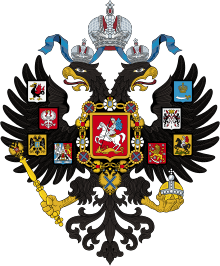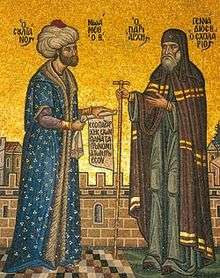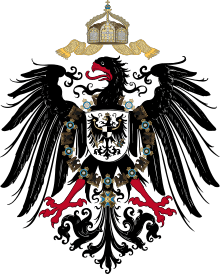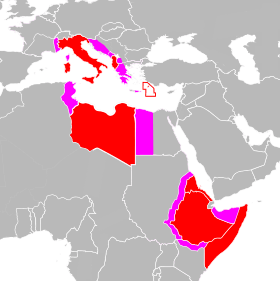Third Rome

Third Rome was the idea that some city, state, or country is the successor to the legacy of ancient Rome (the "first Rome"). The concept of second Rome is disputed according to different perspectives, either via connection to the Byzantine Empire (also known as the "Eastern Roman Empire") as Constantinople being the "second Rome", or via connection to the Western Roman Empire through its claimed successors such as the Papal States or the Holy Roman Empire.
Successor to Byzantium


Russian claims
After the fall of Tǎrnovo to the Ottoman Turks in 1393, a number of Bulgarian clergymen sought shelter in the Russian lands and transferred the idea of the Third Rome there, which eventually resurfaced in Tver, during the reign of Boris of Tver, when the monk Foma (Thomas) of Tver had written The Eulogy of the Pious Grand Prince Boris Alexandrovich in 1453.[2][3]
Within decades after the capture of Constantinople by Mehmed II of the Ottoman Empire on 29 May 1453, some Eastern Orthodox people were nominating Moscow as the "Third Rome", or the "New Rome".[4] Stirrings of this sentiment began during the reign of Ivan III of Russia who had married Sophia Paleologue. Sophia was a niece of Constantine XI, the last Byzantine emperor. By the rules and laws of inheritance followed by most European monarchies of the time, Ivan could claim that he and his offspring were heirs of the fallen Empire, but the Roman traditions of the empire had never recognized automatic inheritance of the Imperial office.[5] A stronger claim was based on religion. The Orthodox faith was central to Byzantine notions of their identity and what distinguished them from "barbarians". Vladimir the Great had converted Kievan Rus' to Orthodoxy in 988, in return for which he became the first barbarian to ever get an Imperial princess as a wife.
The idea of Muscovy as heir to Rome crystallized with a panegyric letter composed by the Russian monk Philotheus (Filofey) of Pskov in 1510 to their son Grand Duke Vasili III, which proclaimed, "Two Romes have fallen. The third stands. And there will be no fourth. No one shall replace your Christian Tsardom!" Contrary to the common misconception, Filofey[6] explicitly identifies Third Rome with Muscovy (the country) rather than with Moscow (the city), although the term "Muscovy" was considered synonymous with the Russian lands at the time. Somewhat notably, Moscow is placed on seven hills, as were Rome and Constantinople.
Ottoman claims
After the fall of Constantinople in 1453 AD, Mehmed II declared himself Kayser-i Rum, literally "Caesar of Rome".[7] The claim was recognized by the Orthodox Patriarch of Constantinople, but not by Roman Catholic Western Europe. Gennadios (Georgios Scholarios), a staunch enemy of the West, had been enthroned Patriarch of Constantinople with all the ceremonial attributes of Byzantium by Mehmed himself acting as Roman Emperor and in turn Gennadios recognized Mehmed as successor to the throne.[8] Mehmed's claim rested with the concept that Constantinople was the seat of the Roman Empire, after the transfer of its capital to Constantinople in 330 AD and the fall of the Western Roman Empire. Mehmed also had a blood lineage to the Byzantine Imperial family; his predecessor, Sultan Orhan I had married a Byzantine princess, and Mehmed may have claimed descent from John Tzelepes Komnenos.[9] During that period the Ottoman Empire also destroyed Otranto and its people, and Mehmed II was planning on taking Rome itself when the Italian campaign was cut short by his sudden death.[10] The title fell into disuse after his death, but the imperial bodies created by Mehmed II lived on for centuries to come.
Successor to the Holy Roman Empire
German claims
.svg.png)


The Carolingian Empire has been claimed to have deliberately sought to revive the Roman Empire in the West.[11] According to early German nationalism, the Carolingian Empire transformed into the Holy Roman Empire as a continuation of the Western Roman Empire.[11] In 800, the title of Holy Roman Emperor (though this referred to the Roman Catholic Church, not the Romans) was granted to Charlemagne by Pope Leo III.
After the Holy Roman Empire was dismantled in 1806, the Austrian Empire sought to lay claim as the heir of the Holy Roman Empire as Austria's Habsburgs attempted to unite Germany under their rule.[11] Later the German Empire in 1871 also claimed to be the Third Rome, also through lineage of the HRE.[12][13] The title for emperors of the Holy Roman Empire, the Austrian Empire and the German Empire was Kaiser, the German word for Emperor.
Claims by the German Empire of 1871 to 1918 of being a "Third Rome" have been criticized because of the fact that the German Empire was led by a Protestant ruler and no concordat had been achieved with the Catholic Church (that was a major basis of the continuation of Roman culture in the West).[13]
Italy's capital as the Third Rome
In Italy, the concept "third Rome" is related to the capital of the Kingdom of Italy, created in 1861.
Risorgimento
Giuseppe Mazzini, Italian nationalist and patriot promoted the notion of the "Third Rome". He said, "After the Rome of the emperors, after the Rome of the Popes, there will come the Rome of the people", addressing Italian unification and the establishment of Rome as the capital.[14] After the unification of Italy into the Kingdom of Italy, the state was referred to as the Third Rome by Italian figures.[15]
After the unification, Mazzini spoke of the need of Italy as a Third Rome to have imperial aspirations.[16] Mazzini said that Italy should "invade and colonize Tunisian lands" as it was the "key to the Central Mediterranean", and he viewed Italy as having the right to dominate the Mediterranean Sea as ancient Rome had done.[16]
Fascist Empire
In his speeches, Italian leader Benito Mussolini referred to his Fascist Italy as a "Third Rome" or as a New Roman Empire.[17] Terza Roma (Third Rome; the Fascist Rome after the Imperial and the Papal ones) was also a name for Mussolini's plan to expand Rome towards Ostia and the sea. The EUR neighbourhood was the first step in that direction.[18]
In recent popular culture
The concept of a "Third Rome" figures greatly in the second memoir of Whittaker Chambers. Although published posthumously as Cold Friday (1964), Chambers had planned it from inception as "The Third Rome". A long chapter called "The Third Rome" does appear in the memoir.[19][20][21]
See also
- Translatio imperii
- Legacy of the Roman Empire
- Legacy of Byzantium
- New Rome
- Papal States
- Byzantium after Byzantium (monograph)
- Russian Empire
Notes
- ↑ Koon, Tracy H. (1985). Believe, Obey, Fight: Political Socialization of Youth in Fascist Italy, 1922-1943. UNC Press Books. p. 20. ISBN 978-0-8078-1652-3. Extract of page 20
- ↑ Robert Auty, Dimitri Obolensky (Ed.), An Introduction to Russian Language and Literature, p. 94, Cambridge University Press 1997, ISBN 0-521-20894-7
- ↑ Alar Laats, The concept of the Third Rome and its political implications, p. 102
- ↑ Parry, Ken; Melling, David, eds. (1999). The Blackwell Dictionary of Eastern Christianity. Malden, MA: Blackwell Publishing. p. 490. ISBN 0-631-23203-6.
- ↑ Nicol, Donald MacGillivray, Last Centuries of Byzantium, 1261–1453, Cambridge University Press, Second Edition, 1993, p. 72
- ↑ Filofey
- ↑ İlber Ortaylı, "Büyük Constantin ve İstanbul", Milliyet, 28 May 2011.
- ↑ Dimitri Kitsikis, Türk-Yunan İmparatorluğu. Arabölge gerçeği ışığında Osmanlı Tarihine bakış – İstanbul, İletişim Yayınları, 1996.
- ↑ Norwich, John Julius (1995). Byzantium:The Decline and Fall. New York: Alfred A. Knopf. pp. 81–82. ISBN 0-679-41650-1.
- ↑ Bunson, Matthew. "How the 800 Martyrs of Otranto Saved Rome". Catholic Answers. Retrieved 30 May 2014.
- 1 2 3 Craig M. White. The Great German Nation: Origins and Destiny. AuthorHouse, 2007. P. 139.
- ↑ Warwick Ball. Rome in the East: The Transformation of an Empire. London, England, UK: Routledge, 2000. P. 449.
- 1 2 Craig M. White. The Great German Nation: Origins and Destiny. AuthorHouse, 2007. P. 169.
- ↑ Rome Seminar
- ↑ Christopher Duggan. The Force of Destiny: A History of Italy Since 1796. New York, New York, USA: Houghton Mifflin Harcourt, 2008. P. 304.
- 1 2 Silvana Patriarca, Lucy Riall. The Risorgimento Revisited: Nationalism and Culture in Nineteenth-Century Italy. P. 248.
- ↑ Martin Clark, Mussolini: Profiles in Power (London: Pearson Longman, 2005), 136.
- ↑ Discorso pronunciato in Campidoglio per l'insediamento del primo Governatore di Roma il 31 dicembre 1925, Internet Archive copy of a page with a Mussolini speech.
- ↑ Chambers, Whittaker (1964). Cold Friday. New York: Random House.
- ↑ O’Brien, Conor Cruise (19 November 1964). "The Perjured Saint". The New York Review of Books.
- ↑ Chambers, David (9 July 2011). "Whittaker Chambers (1901–1961): Ghosts and Phantoms". WhittakerChambers.org.
Bibliography
- Chambers, Whittaker (1964). Cold Friday. New York: Random House.
- Dmytryshyn, Basil (transl). 1991. Medieval Russia: A Source Book, 850–1700. 259–261. Harcourt Brace Jovanovich. Fort Worth, Texas.
- Poe, Marshall. "Moscow, the Third Rome: the Origins and Transformations of a 'Pivotal Moment'." Jahrbücher für Geschichte Osteuropas (2001) (In Russian: "Izobretenie kontseptsii "Moskva—Tretii Rim". Ab Imperio. Teoriia i istoriia natsional'nostei i natsionalizma v postsovetskom prostranstve 1: 2 (2000), 61–86.)
- Martin, Janet. 1995. Medieval Russia: 980-1584. 293. Cambridge University Press. Cambridge, UK.
- Stremooukhoff, Dimitri (January 1953). "Moscow The Third Rome: Sources of the Doctrine". Speculum. 84–101.
.svg.png)

